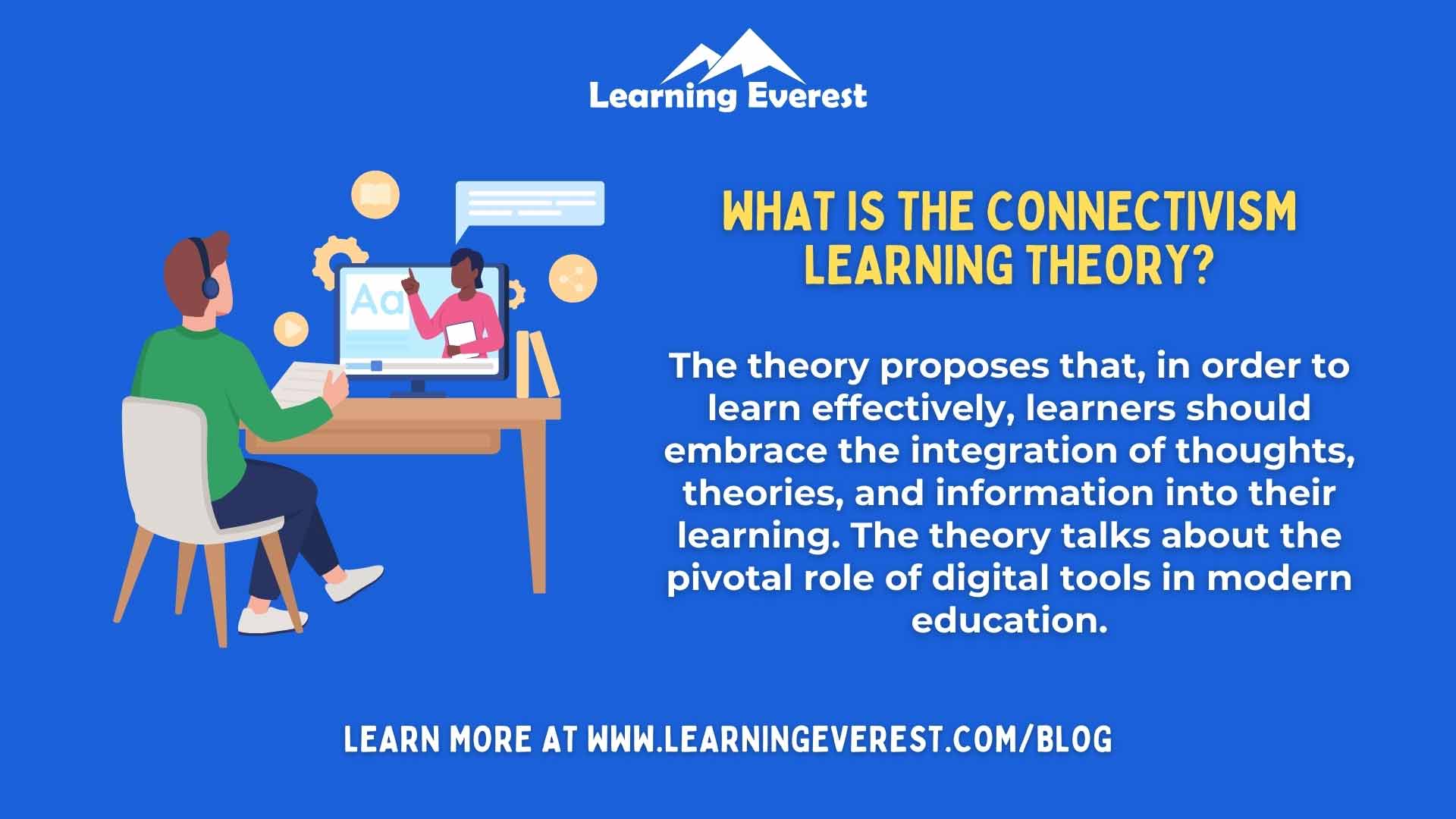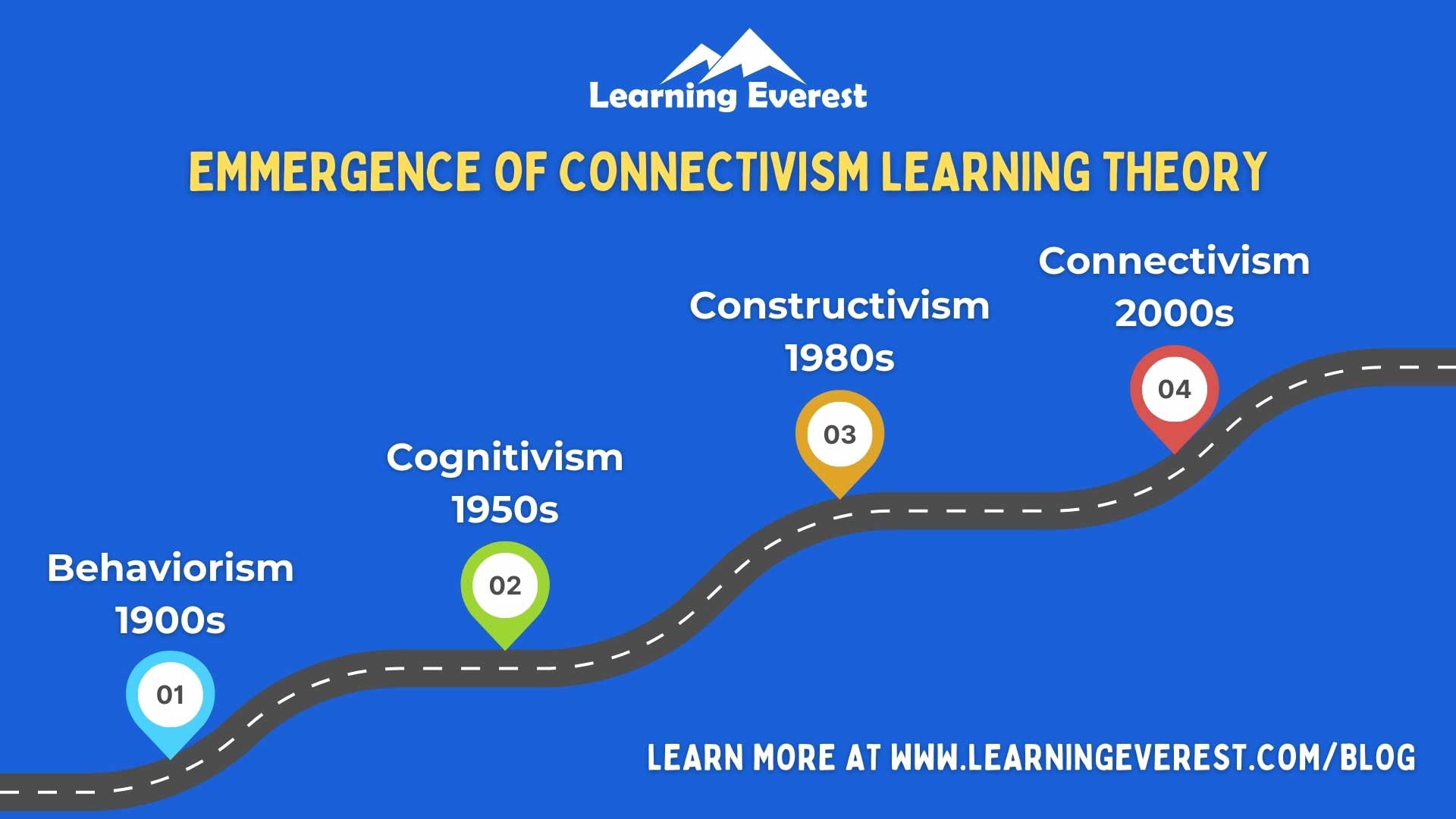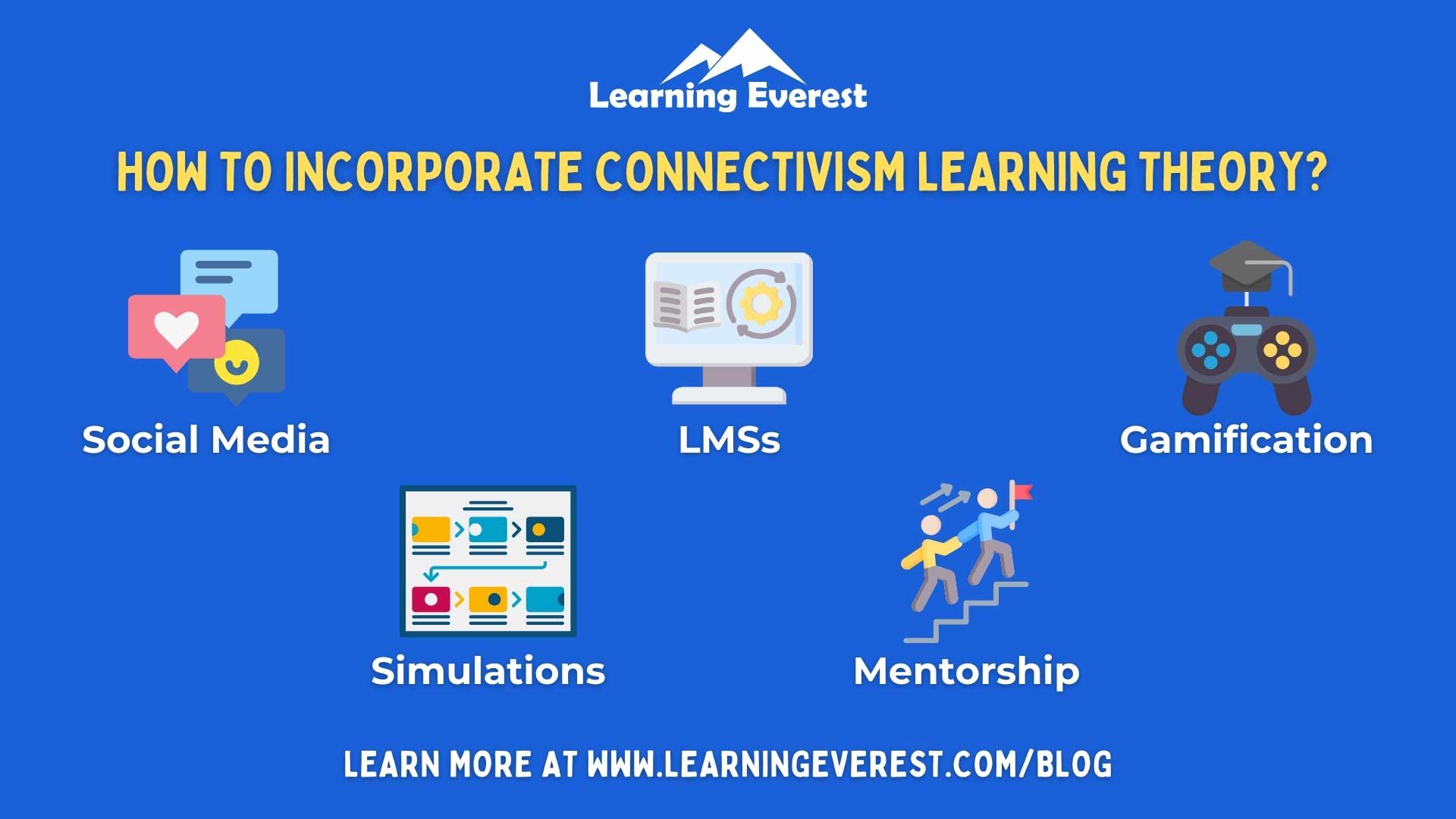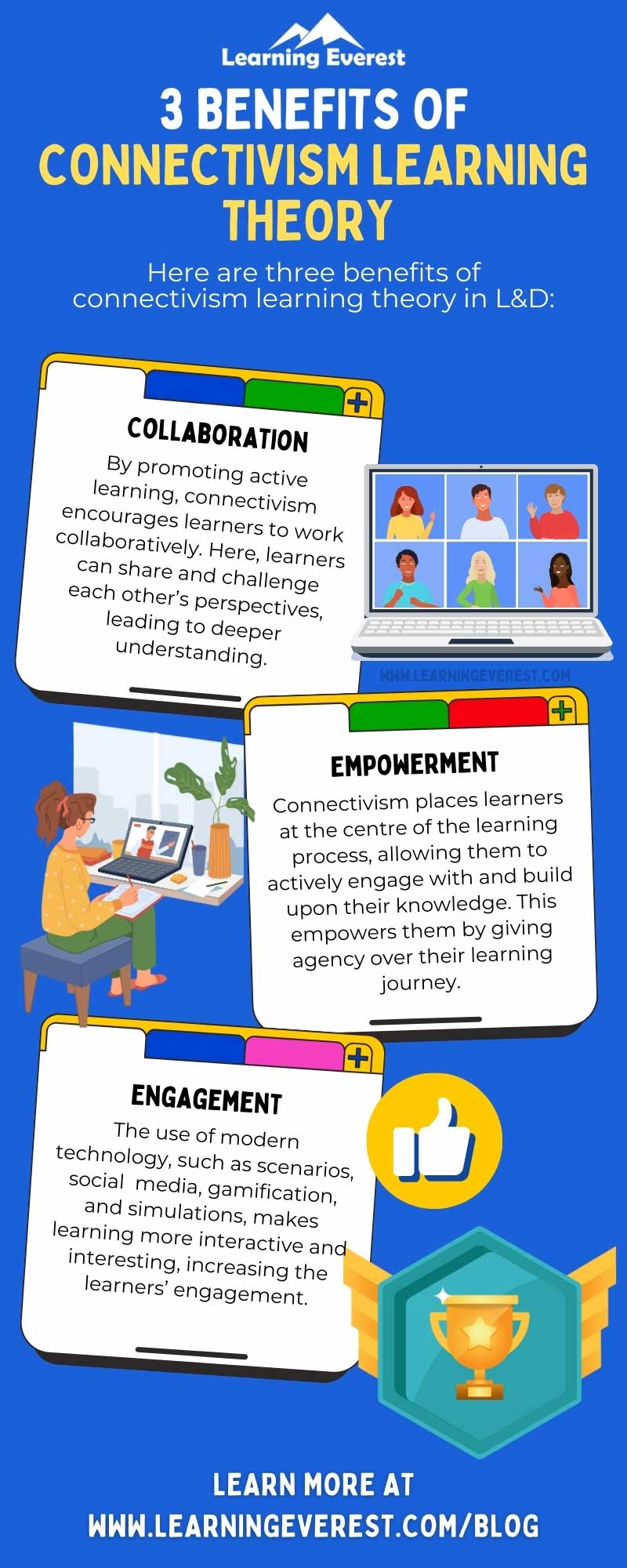Connectivism learning theory is a relatively new learning theory that suggests learners should combine thoughts, theories, and general information in a useful manner. Confused? Keep reading!
Table of Contents
- What is connectivism learning theory?
- The history behind connectivism learning theory
- What are the core principles of connectivism learning theory?
- Connectivism learning theory in the L&D
- Here are a few specific ways to incorporate connectivism learning theory in L&D:
- To sum up
- Infographic
- Knowledge Check!
- Frequently Asked Questions (FAQs)
- What is the connectivism learning theory?
- Who developed connectivism learning theory?
- What are the implications of connectivism learning theory?
What is connectivism learning theory?
The theory proposes that, in order to learn effectively, learners should embrace the integration of thoughts, theories, and information into their learning. The theory talks about the pivotal role of digital tools in modern education. It accepts that our constant connectedness gives us opportunities to make choices about our learning. It also promotes group collaboration and discussion, allowing for different viewpoints and perspectives when it comes to decision-making, problem-solving, and making sense of information. Connectivism learning happens outside of an individual mind, such as via social media, online networks, blogs, or information databases, so on.

What is the Connectivism Learning Theory?
According to this theory, learning is more than how we construct the knowledge. Rather, what we can reach in our external networks is also considered to be learning. Nodes and links have been commonly used to describe how we gain and connect information in a network. Learners are seen as “nodes” in a network. A node refers to any object that can be connected to another object, like a book, webpage, person, etc. Connectivism learning is based on the theory that we learn when we make connection or “link” between different “nodes” of information, and we continue to develop and maintain connections in order to form knowledge.
The history behind connectivism learning theory
Connectivism was first introduced by two theorists, George Siemens and Stephen Downes, in 2005. There are two articles by them: Siemens’ article Connectivism: Learning as a Network Creation was published in 2004 and Downes’ article An Introduction to Connective Knowledge was published the following year.

Emmergence of Connectivism Learning Theory
The publications address the important role technology plays in the learning process and how the digital age has increased the speed at which students have access to information. Since then, both Siemens and Downes have continued to write and speak on the subject. However, each has slightly different viewpoints. Siemens has largely concentrated on exploring the social dimensions and interactions underpinning the theory. On the other hand, Downes has delved deeper into the realm of artificial intelligence, considering how both non-human entities and machine-based tools can facilitate learning.
What are the core principles of connectivism learning theory?
Connectivism builds on already-established theories to propose that technology is changing what, how, and where we learn. In their research, Siemens and Downes identified eight principles of connectivism. The main principles of connectivism are:
- Learning and knowledge happen in a diversity of opinions.
- Learning is a process of connecting.
- Learning may reside in non-human applications.
- The capacity to know more is more important than what is currently known.
- Fostering and maintaining links between nodes is needed to facilitate continual learning.
- Ability to see connections between various fields, ideas, and concepts is na important skill. We must learn how to build a link to connect point A to point B.
- Accurate, up-to-date information is the intent of all connectivism learning.
- Decision-making is itself a learning process.
Connectivism learning theory in the L&D
Connectivism learning theory presents a modern shift in L&D approaches, distinguishing itself from the traditional classroom setting. While you may be able to understand the key goals of connectivism, the real challenge lies in its practical application. A defining characteristic of connectivism is its deep-rooted alliance with technology. To truly foster a connectivism learning setting, L&D professionals must effectively integrate digital learning opportunities. This might include incorporating a range of platforms and tools, from online courses and webinars to social networks and generative AI applications. These not only cater to varied learning styles but can also provide an economical solution for organizations on limited budgets.
Here are a few specific ways to incorporate connectivism learning theory in L&D:

How to Incorporate Connectivism Learning Theory?
Let’s discuss in detail.
1 – Social Media
Social media can enhance traditional corporate learning by offering a wealth of educational resources on social platforms like LinkedIn, Behance, Facebook, and so on. This promotes global networking and collaborative learning. It opens up discussions to interested parties beyond the workplace. This allows them to link their knowledge in real-world contexts and understand the learning processes behind these actions through discussions and Q&A sessions. However, instructors must ensure digital safety and manage distractions in order to ensure the use of social media in the workplace is successful.
To learn more, you can read our blog on What is social facilitation in a learning experience?
2 – Learning management systems (LMSs)
There is no question that online learning is the way of the future. And for that you need an effective mechanism for online training. Learning management systems (LMSs) are the base of online learning. An LMS is needed to create and distribute online courses and manage your learning programs. LMSs help learning L&D managers operate the entire life cycle of the learning process within an organization. Learning management professionals use their LMSs to store and distribute courses to employees as needed. Learners take courses and submit feedback using the LMS interface. A good LMS lets admins monitor learner progress, view data analytics, and adjust their learning programs for maximum impact.
To learn more, you can read our blog on Moodle LMS: Features and Benefits.
3 – Gamification
In connectivism learning, gamification can be used as a dynamic tool, latching on to learners’ innate desire for challenge and reward. By integrating game-like elements, instructors can encourage engagement and foster creative collaboration. For example, leaderboards or achievement badges can motivate learners to delve deeper into topics, while collaborative games can strengthen networking and peer-to-peer learning. Although instructors must strike a balance which ensures that learning is not overshadowed by game mechanics.
To learn more about gamification, read our blog on 5 Game Mechanics to Use in eLearning with Gamification Examples.
4 – Simulations
Computer simulations can offer an immersive learning environment, allowing learners to experiment, make decisions, and observe outcomes in a controlled setting. These simulations can help learners think about difficult concepts and abstract ideas in a safe and cost-effective manner. An example would be that of a simulation of safety training which lets learners interact with danger workplace situations virtually. Such interactive approaches, underpinned by connectivism, can be personalized to each learners, empowering them to build knowledge networks and deepen their comprehension.
The goal of this type of learning is to identify a solution or an answer to a real-world problem. Scenario-based learning can be used to give compliance training, soft skills training, professional skills training, leadership training, etc. A scenario-based learning environment is exceptional for keeping the learners engaged throughout their learning journey. It creates real experiences.
To learn more read our blog on How can you integrate scenario-based learning into your customer service training modules?
5 – Mentorship programs
Workplace mentorship programs support connectivism by bringing together employees at different stages in their careers to swap internal knowledge and discuss case studies. This can inspire others to perform better work or develop particular skills. Mentors can showcase success stories within your organization to inspire your employees and demonstrate how others have successfully navigated similar development paths before. They inspire healthy competition in the workplace. Those who work with them notice how well they perform, and it may inspire them to produce work on the same level or above their level. This atmosphere motivates everyone to place extra effort into their work and achieve new goals.
Do you like to add anything? Comment us below!
To sum up
Connectivism maps onto the significant shifts occurring in contemporary L&D programs, tracing the transition from individual to collaborative learning. Connectivism offers valuable insights for modern learning and development programs, which, through the incorporation of social media and generative AI, can link learners with global experts, enriching the learning experience.
Infographic
Knowledge Check!
Frequently Asked Questions (FAQs)
What is the connectivism learning theory?
The theory proposes that, in order to learn effectively, learners should embrace the integration of thoughts, theories, and information into their learning. The theory talks about the pivotal role of digital tools in modern education.
Who developed connectivism learning theory?
Connectivism was first introduced by two theorists, George Siemens and Stephen Downes, in 2005. There are two articles by them: Siemens’ article Connectivism: Learning as a Network Creation was published in 2004 and Downes’ article An Introduction to Connective Knowledge was published the following year.
What are the implications of connectivism learning theory?
To truly foster a connectivism learning setting, L&D professionals must effectively integrate digital learning opportunities. This might include incorporating a range of platforms and tools, from online courses and webinars to social networks and generative AI applications.






